The global floor-standing filtered bottle filling stations market is projected to grow from USD 87.8 million in 2025 to approximately USD 182.7 million by 2035, recording an absolute increase of USD 94.9 million over the forecast period. This translates into a total growth of 108.1%, with the market forecast to expand at a compound annual growth rate (CAGR) of 7.6% between 2025 and 2035.
The overall market size is expected to grow by nearly 2.08X during the same period, supported by increasing demand for hygienic water dispensing solutions, growing adoption of filtered water systems in public facilities, and rising requirements for sustainable hydration solutions across diverse commercial, institutional, and public applications in the global water treatment and facility management industries.
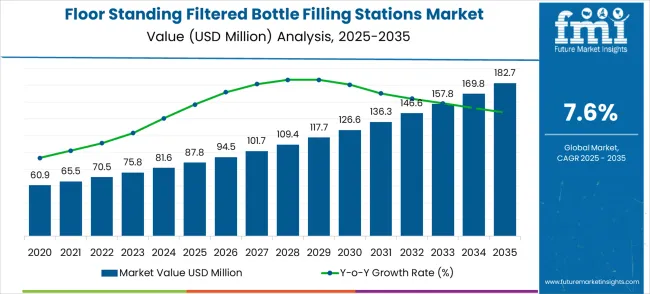
| Metric | Value |
|---|---|
| Estimated Value in (2025E) | USD 87.8 million |
| Forecast Value in (2035F) | USD 182.7 million |
| Forecast CAGR (2025 to 2035) | 7.6% |
From 2030 to 2035, the market is forecast to grow from USD 117.7 million to USD 182.7 million, adding another USD 65.0 million, which constitutes 68.5% of the overall ten-year expansion. This period is expected to be characterized by the expansion of smart water dispensing technologies, the integration of IoT connectivity for usage monitoring and maintenance optimization, and the development of specialized filling stations for emerging applications, including contactless operation and enhanced hygiene features. The growing emphasis on public health and hygiene standards will drive demand for advanced filtered bottle filling stations with antimicrobial surfaces, touchless operation, and real-time water quality monitoring capabilities.
Between 2020 and 2024, the floor-standing filtered bottle filling stations market experienced steady growth, driven by increasing awareness of plastic waste reduction and growing recognition of filtered water systems' importance in promoting sustainable hydration practices. The market developed as facility managers recognized the potential for bottle filling stations to enhance user convenience while meeting environmental sustainability objectives. Technological advancement in filtration technology and dispensing systems began emphasizing the critical importance of maintaining water quality while improving user experience and operational efficiency.
Market expansion is being supported by the increasing global focus on environmental sustainability and plastic waste reduction, and the corresponding shift toward reusable bottle solutions that can provide convenient water access while meeting facility requirements for sustainable operations and user satisfaction. Modern facility managers and environmental administrators are increasingly focused on incorporating filtered bottle filling stations to enhance sustainability initiatives while satisfying demands for convenient hydration, water quality assurance, and cost-effective facility operations. Filtered bottle filling technology's proven ability to deliver superior water quality, operational convenience, and environmental benefits makes it an essential solution for educational facilities, corporate offices, healthcare institutions, and public building applications.
The growing emphasis on public health and hygiene standards is driving demand for high-quality water dispensing systems that can support safe hydration protocols and maintain superior water quality across schools, hospitals, airports, and recreational facilities. Facility preference for equipment that combines convenience with environmental responsibility is creating opportunities for innovative filling station implementations in both traditional institutional and emerging commercial applications. The rising influence of corporate sustainability initiatives and green building standards is also contributing to increased adoption of water conservation systems that can provide reliable performance while supporting environmental goals.
The market is segmented by machine type, application, and region. By machine type, the market is divided into aseptic filling machines, high precision filling machines, and others. Based on application, the market is categorized into food and beverage, the medical industry, and others. Regionally, the market is divided into North America, Europe, Asia Pacific, Latin America, and the Middle East & Africa.
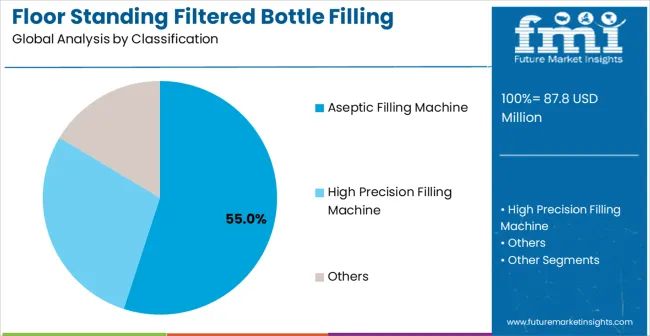
The aseptic filling machine segment is projected to account for 55% share of the floor-standing filtered bottle filling stations market in 2025, reaffirming its position as the leading machine type category. Healthcare facilities and food service operators increasingly utilize aseptic filling systems for their superior contamination prevention, reliable sterility maintenance, and ability to provide safe water dispensing across sensitive environments and high-hygiene applications. Aseptic filling technology's proven effectiveness and established safety standards directly address facility requirements for contamination control and health safety compliance in critical applications.
This machine type segment forms the foundation of modern water dispensing applications, as it represents the technology with the greatest safety assurance and established compatibility across multiple sensitive environments and hygiene-critical scenarios. Manufacturer investments in aseptic system optimization and contamination prevention continue to strengthen adoption among healthcare and food service professionals. With facilities prioritizing user safety and contamination prevention, aseptic filling technology aligns with both health protection objectives and regulatory compliance requirements, making it the central component of comprehensive water safety strategies.
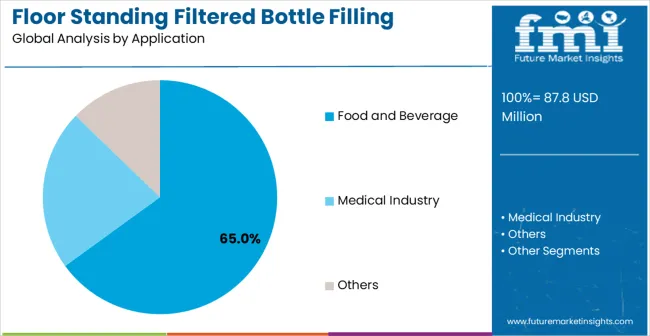
Food and beverage applications are projected to represent 65% share of floor-standing filtered bottle filling station demand in 2025, underscoring their critical role as the primary application area for commercial hydration solutions and food service facility operations. Food service operators prefer filtered filling stations for their ability to provide consistent water quality, superior contamination control, and the capacity to support both customer service and operational efficiency while maintaining food safety standards. Positioned as essential food service equipment, filtered bottle filling stations offer both operational convenience and hygiene assurance advantages.
The segment is supported by continuous growth in food service industry standards and the increasing availability of specialized filling systems that enable enhanced customer service and improved operational efficiency at the commercial level. Additionally, food service facilities are investing in advanced water dispensing equipment to support customer satisfaction and regulatory compliance. As food service operations become more sophisticated and operators seek superior hydration solutions, food and beverage applications will continue to drive market demand while supporting innovation and service enhancement strategies.
The floor-standing filtered bottle filling stations market is advancing steadily due to increasing environmental consciousness and growing demand for sustainable hydration solutions that emphasize convenience and water quality across educational institutions, corporate facilities, and public building applications. However, the market faces challenges, including high initial installation costs, maintenance requirements for filtration systems, and competition from alternative hydration solutions. Innovation in smart technologies and touchless operation continues to influence market development and expansion patterns.
The growing adoption of floor-standing filtered bottle filling stations in sustainability programs and plastic reduction initiatives is enabling facilities to achieve environmental goals that provide measurable waste reduction while supporting user convenience and cost savings through reduced bottled water purchases. Sustainability applications provide exceptional environmental benefits while allowing more sophisticated facility management across various institutional and commercial environments. Facility managers are increasingly recognizing the competitive advantages of water filling stations for ecological leadership and operational cost reduction.
Modern floor-standing filtered bottle filling station manufacturers are incorporating usage monitoring systems, maintenance alerts, and remote connectivity features to enhance operational efficiency, improve maintenance scheduling, and meet demands for intelligent facility management in modern building operations. These technologies improve system reliability while enabling new applications, including predictive maintenance programs and usage analytics. Advanced technology integration also allows manufacturers to support premium market positioning and operational excellence beyond traditional water dispensing functionality.
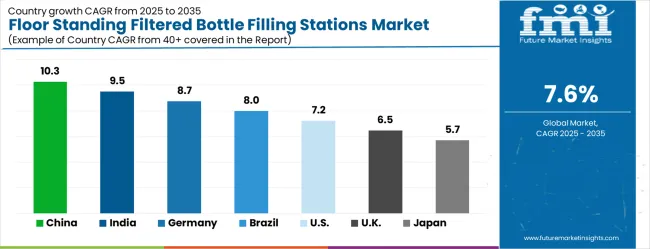
| Country | CAGR (2025-2035) |
|---|---|
| China | 10.3% |
| India | 9.5% |
| Germany | 8.7% |
| Brazil | 8.0% |
| USA | 7.2% |
| UK | 6.5% |
| Japan | 5.7% |
The floor-standing filtered bottle filling stations market is experiencing robust growth globally, with China leading at a 10.3% CAGR through 2035, driven by rapid urbanization, expanding educational infrastructure, and increasing adoption of modern facility management technologies. India follows at 9.5%, supported by growing educational sector development, rising environmental awareness, and increasing investment in public facility modernization. Germany shows growth at 8.7%, emphasizing ecological sustainability excellence and green building standard implementation. Brazil records 8.0%, focusing on educational infrastructure development and environmental consciousness initiatives. The USA demonstrates 7.2% growth, prioritizing sustainability programs and facility modernization. The UK exhibits 6.5% growth, supported by established environmental standards and public facility enhancement. Japan shows 5.7% growth, emphasizing technological innovation and facility efficiency optimization.
The report covers an in-depth analysis of 40+ countries top-performing countries are highlighted below.
The floor-standing filtered bottle filling station market in China is expected to experience strong growth, with a CAGR of 10.3% through 2035, driven by massive urbanization projects and increasing investment in modern educational and public facility infrastructure across major cities and developing regions. The country's growing middle-class population and rising environmental consciousness are creating substantial demand for sustainable hydration solutions in schools, universities, office buildings, and public facilities. Major facility equipment manufacturers and water treatment companies are establishing comprehensive production and distribution capabilities to serve both domestic infrastructure development and export markets.
The floor-standing filtered bottle filling station market in India is projected to grow at a CAGR of 9.5%, supported by comprehensive educational sector expansion, increasing government investment in public facility modernization, and growing awareness of environmental sustainability among institutional administrators. The country's expanding educational infrastructure and rising focus on student health and safety are driving demand for reliable water dispensing solutions across schools, colleges, and public institutions. International facility equipment companies and domestic manufacturers are establishing comprehensive production and service capabilities to address growing market demand for hygienic water systems.
Revenue from floor-standing filtered bottle filling stations in Germany is projected to grow at a CAGR of 8.7% through 2035, driven by the country's leadership in environmental sustainability, comprehensive green building standards, and strong commitment to plastic waste reduction initiatives across corporate and institutional facilities. Germany's sophisticated environmental regulations and advanced facility management practices are creating substantial demand for sustainable water dispensing solutions across both commercial and public applications. Leading facility equipment manufacturers and technology suppliers are establishing comprehensive development strategies to serve both German sustainability requirements and European export markets.
Demand for floor-standing filtered bottle filling stations in Brazil is projected to grow at a CAGR of 8.0% through 2035, supported by expanding educational infrastructure investment, growing environmental awareness among institutional administrators, and increasing focus on public health improvement in schools and public facilities. Brazilian institutions are increasingly adopting sustainable hydration solutions to enhance facility services and environmental responsibility. The country's strategic focus on education and public health continues to drive innovation in facility management applications and equipment adoption.
Revenue from floor-standing filtered bottle filling stations in the United States is projected to grow at a CAGR of 7.2% through 2035, supported by comprehensive sustainability programs, advanced facility management practices, and leadership in environmental initiative implementation across educational, corporate, and public sector facilities. American facility managers prioritize sustainability, operational efficiency, and user satisfaction, making filtered bottle filling stations essential equipment for both institutional sustainability goals and operational cost management. The country's extensive environmental awareness and facility modernization support continued market development and technology advancement.
The floor-standing filtered bottle filling station market in the United Kingdom is expected to grow at a CAGR of 6.5% through 2035, supported by established environmental standards, comprehensive facility management traditions, and a strong commitment to sustainability initiatives across educational and public sector facilities. UK facility managers' focus on environmental responsibility and operational excellence creates steady demand for sustainable water dispensing solutions across both traditional institutional and emerging commercial applications. The country's expertise in ecological management drives consistent adoption of advanced facility technologies.
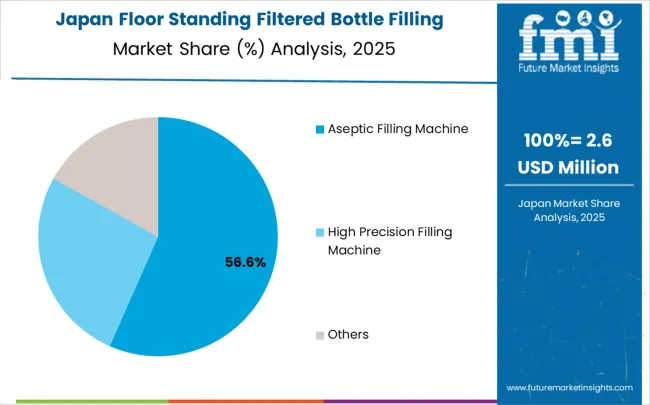
The floor-standing filtered bottle filling station market in Japan is expected to grow at a CAGR of 5.7% through 2035, supported by the country's commitment to technological innovation, advanced facility management systems, and emphasis on operational efficiency and space optimization in institutional and commercial environments. Japan's facility management sector continues to prioritize innovation and efficiency while working to enhance facility services through advanced equipment integration and technology optimization.
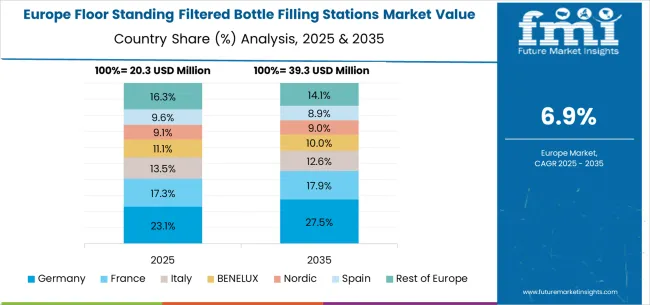
The floor-standing filtered bottle filling stations market in Europe is projected to grow from USD 31.9 million in 2025 to USD 66.3 million by 2035, registering a CAGR of 7.6% over the forecast period. Germany is expected to maintain its leadership position with a 32.6% market share in 2025, declining slightly to 32.1% by 2035, supported by its advanced environmental standards, comprehensive sustainability programs, and extensive facility management excellence serving European and international markets.
The United Kingdom follows with a 26.3% share in 2025, projected to reach 25.9% by 2035, driven by established environmental management traditions, strong facility modernization programs, and comprehensive sustainability initiative implementation. France holds an 18.7% share in 2025, expected to maintain 18.9% by 2035, supported by strong public facility development and growing investment in environmental technologies. Italy commands a 12.4% share in 2025, projected to reach 12.7% by 2035, while Spain accounts for 6.2% in 2025, expected to reach 6.5% by 2035. The Netherlands maintains a 1.8% share in 2025, growing to 1.9% by 2035. The Rest of Europe region, including Nordic countries, Eastern Europe, Belgium, Switzerland, and Austria, is anticipated to hold 2.0% in 2025, growing to 2.0% by 2035, attributed to mixed growth patterns with increasing adoption of environmental technologies in some Eastern European markets balanced by specialized facility requirements in smaller Western European countries implementing sustainability enhancement programs.
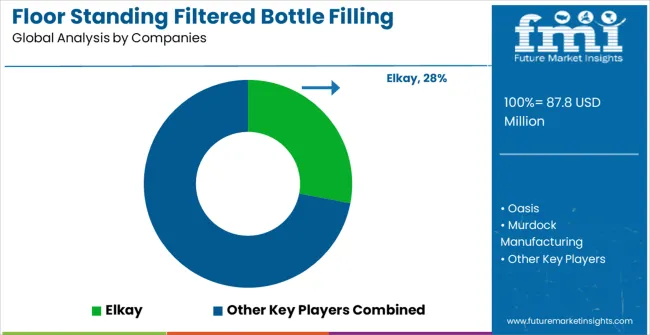
The floor-standing filtered bottle filling stations market is characterized by competition among established water treatment equipment manufacturers, specialized hydration system providers, and integrated facility management solution suppliers. Companies are investing in advanced filtration technologies, smart connectivity features, hygiene enhancement systems, and comprehensive maintenance programs to deliver consistent, high-performance, and user-friendly water dispensing solutions. Innovation in touchless operation, IoT integration, and antimicrobial materials is central to strengthening market position and user satisfaction.
Elkay leads the market with a strong focus on water delivery innovation and comprehensive hydration solutions, offering extensive bottle filling station portfolios that emphasize durability, performance, and environmental benefits. Oasis provides specialized water treatment capabilities with a focus on filtration excellence and commercial application expertise. Murdock Manufacturing delivers facility equipment solutions with a focus on institutional applications and reliability. Sidel specializes in beverage packaging and filling technologies with emphasis on commercial-scale applications and operational efficiency. Acorn Engineering focuses on drinking fountains and water dispensing systems with emphasis on public facility applications. Most Dependable Fountains emphasizes water delivery equipment with a focus on reliability and service support.
Floor-standing filtered bottle filling stations represent a specialized segment within the sustainable facility management and water treatment ecosystem, with market growth from USD 87.8 million in 2025 to USD 182.7 million by 2035, reflecting increasing environmental consciousness, plastic waste reduction initiatives, and demand for hygienic water dispensing solutions across educational, commercial, and public facilities. The technology enables facility managers to provide convenient water access while supporting sustainability objectives through reduced single-use plastic consumption and enhanced water quality assurance. Aseptic filling machines dominate market demand due to their superior contamination prevention and safety compliance capabilities, while Food and Beverage applications represent the largest segment, driven by commercial food service operations and regulatory hygiene requirements. However, market development faces challenges from high initial installation costs, ongoing maintenance requirements, and competition from alternative hydration solutions, requiring coordinated stakeholder action to address cost barriers, maintenance optimization, and technology advancement while capitalizing on environmental sustainability trends and facility modernization initiatives.
How Environmental Agencies and Sustainability Organizations Could Drive Market Adoption?
Plastic Waste Reduction Programs and Incentives: Establish comprehensive bottle filling station installation incentives through grants, tax credits, and regulatory requirements that promote single-use plastic reduction in public facilities, educational institutions, and commercial buildings. Create measurable waste reduction targets and tracking systems that demonstrate environmental impact while supporting facility managers in achieving sustainability goals through quantifiable plastic consumption reductions.
Green Building Standards and Certification Requirements: Integrate bottle filling station requirements into LEED, BREEAM, and other green building certification programs that incentivize sustainable facility design and operation. Develop point systems and recognition programs that reward facilities implementing comprehensive hydration solutions that combine environmental benefits with operational efficiency and user convenience.
Public Awareness and Education Campaigns: Launch community outreach programs educating facility managers, educators, and building operators about environmental benefits, cost savings, and user satisfaction improvements achieved through bottle filling station implementation. Create best practice guides and case study databases documenting successful installations across different facility types and operational environments.
Policy Development and Regulatory Support: Advocate for legislation supporting bottle filling station installation in new construction and major renovation projects, particularly in schools, hospitals, and public buildings where environmental leadership and public health intersect. Establish procurement guidelines for government facilities that prioritize sustainable hydration solutions in facility planning and infrastructure development.
How Equipment Manufacturers Could Advance Technology and Market Infrastructure?
Advanced Filtration and Water Quality Systems: Develop next-generation filtration technologies that ensure superior water quality while reducing maintenance requirements and operational costs. Integrate multi-stage filtration, UV sterilization, and real-time water quality monitoring systems that provide facility managers with confidence in water safety while minimizing system downtime and service requirements.
Smart Technology Integration and IoT Connectivity: Create intelligent bottle filling stations with usage tracking, predictive maintenance alerts, and remote monitoring capabilities that optimize operational efficiency and reduce maintenance costs. Develop mobile applications and cloud-based management platforms that enable facility managers to monitor multiple installations, track usage patterns, and schedule maintenance proactively.
Touchless Operation and Hygiene Enhancement: Implement advanced sensor technologies, antimicrobial surfaces, and touchless operation systems that address heightened hygiene concerns while improving user experience. Develop self-sanitizing mechanisms and UV-C disinfection capabilities that ensure surface cleanliness and water quality safety between uses.
Modular Design and Installation Flexibility: Design scalable systems that accommodate different facility requirements from small offices to large institutions, enabling cost-effective deployment across diverse applications. Create standardized installation interfaces and modular components that reduce installation complexity and allow future upgrades without complete system replacement.
How Facility Management Companies and Building Operators Could Maximize Implementation Success?
Comprehensive Installation Planning and Site Assessment: Develop systematic evaluation processes for identifying optimal bottle filling station locations based on foot traffic patterns, existing infrastructure, and maintenance accessibility. Create standardized installation procedures that minimize disruption while ensuring optimal performance and user accessibility across different facility types.
User Education and Adoption Programs: Implement comprehensive user education initiatives that promote bottle filling station benefits, proper usage techniques, and environmental impact awareness. Create behavioral change campaigns that encourage reusable bottle adoption while highlighting cost savings and environmental benefits for facility users.
Maintenance Optimization and Service Management: Establish preventive maintenance programs that maximize system uptime and water quality consistency while controlling operational costs. Develop relationships with qualified service providers and create maintenance schedules that align with facility operations, minimizing user disruption.
Performance Monitoring and ROI Analysis: Implement comprehensive tracking systems that monitor usage patterns, maintenance costs, and environmental impact to demonstrate return on investment and support expansion decisions. Create reporting capabilities that document water consumption reduction, plastic waste elimination, and user satisfaction improvements.
How Educational Institutions and Public Facilities Could Lead Market Development?
Pilot Program Implementation and Case Study Development: Establish demonstration installations that showcase technology benefits and operational effectiveness across different institutional environments. Document usage patterns, maintenance requirements, and user satisfaction data that support broader adoption decisions and funding justification for expanded deployment.
Student and Community Engagement Initiatives: Create educational programs that highlight environmental benefits and encourage reusable bottle adoption among students and facility users. Develop sustainability curriculum components that use bottle filling stations as practical examples of environmental stewardship and resource conservation.
Procurement Collaboration and Bulk Purchasing: Coordinate with other institutions to achieve economies of scale through group purchasing programs that reduce equipment costs and installation expenses. Develop shared procurement specifications and vendor relationships that benefit multiple institutions while ensuring consistent performance standards.
Research and Performance Validation: Conduct comprehensive studies documenting health benefits, environmental impact, and operational efficiency improvements achieved through bottle filling station implementation. Share research findings and best practices with other institutions to accelerate adoption and optimize implementation strategies.
How Food Service and Healthcare Organizations Could Expand Application Scope?
Hygiene Protocol Development and Compliance: Establish comprehensive sanitation procedures and quality assurance protocols that ensure bottle filling stations meet food safety and healthcare hygiene requirements. Create staff training programs covering proper maintenance, cleaning procedures, and regulatory compliance specific to food service and healthcare environments.
Integration with Existing Operations: Develop implementation strategies that integrate bottle filling stations with existing food service operations, cafeteria systems, and patient care protocols. Create workflow optimization plans that enhance existing operational procedures while providing additional service capabilities.
Regulatory Compliance and Safety Standards: Ensure installations meet all relevant health department requirements, FDA regulations, and healthcare facility standards through proper specification and installation procedures. Develop documentation and certification processes that demonstrate compliance and support regulatory approval for healthcare and food service applications.
Staff Training and Operational Excellence: Create comprehensive training programs for food service and healthcare staff covering operation, maintenance, and troubleshooting procedures. Establish quality control protocols that ensure consistent water quality and system performance in critical-use environments.
How Investors and Financial Enablers Could Support Market Expansion?
Technology Innovation and Product Development Investment: Finance research and development programs focused on advanced filtration systems, smart technology integration, and next-generation hygiene features that differentiate products and expand market appeal. Support startups developing complementary technologies, including water quality sensors, predictive maintenance systems, and user interface innovations.
Market Expansion and Regional Development: Provide capital for manufacturers expanding into high-growth markets, including China (10.3% CAGR) and India (9.5% CAGR), where infrastructure development and environmental awareness create significant opportunities for growth. Finance regional manufacturing capabilities and distribution networks that enable competitive pricing and responsive customer service.
Facility Financing and Installation Programs: Develop specialized financing solutions that address the capital requirements and payback periods associated with bottle filling station installations. Create lease programs, equipment financing, and performance-based contracts that reduce upfront costs while enabling facility managers to benefit from operational savings and environmental improvements.
Public-Private Partnership Development: Support collaborative initiatives between equipment manufacturers, facility operators, and environmental organizations that accelerate adoption through shared funding and risk mitigation. Finance demonstration programs and pilot installations that validate technology benefits and support broader market acceptance.
Supply Chain Investment and Vertical Integration: Finance supply chain improvements, including component sourcing, manufacturing automation, and service network development that support market expansion and customer satisfaction. Support vertical integration strategies that provide manufacturers greater control over component costs, quality, and delivery while enabling competitive pricing and service excellence.
| Items | Values |
|---|---|
| Quantitative Units (2025) | USD 87.8 million |
| Machine Type | Aseptic Filling Machine, High Precision Filling Machine, Others |
| Application | Food and Beverage, Medical Industry, Others |
| Regions Covered | North America, Europe, Asia Pacific, Latin America, Middle East & Africa |
| Countries Covered | United States, Canada, United Kingdom, Germany, France, China, Japan, South Korea, India, Brazil, Australia and 40+ countries |
| Key Companies Profiled | Elkay, Oasis, Murdock Manufacturing, Sidel, Acorn Engineering, Most Dependable Fountains, Tetra Pak |
| Additional Attributes | Dollar sales by machine type and application, regional demand trends, competitive landscape, technological advancements in filtration systems, smart connectivity development programs, hygiene enhancement initiatives, and sustainable hydration solution strategies |
The global floor standing filtered bottle filling stations market is estimated to be valued at USD 87.8 million in 2025.
The market size for the floor standing filtered bottle filling stations market is projected to reach USD 182.7 million by 2035.
The floor standing filtered bottle filling stations market is expected to grow at a 7.6% CAGR between 2025 and 2035.
The key product types in floor standing filtered bottle filling stations market are aseptic filling machine, high precision filling machine and others.
In terms of application, food and beverage segment to command 65.0% share in the floor standing filtered bottle filling stations market in 2025.






Our Research Products

The "Full Research Suite" delivers actionable market intel, deep dives on markets or technologies, so clients act faster, cut risk, and unlock growth.

The Leaderboard benchmarks and ranks top vendors, classifying them as Established Leaders, Leading Challengers, or Disruptors & Challengers.

Locates where complements amplify value and substitutes erode it, forecasting net impact by horizon

We deliver granular, decision-grade intel: market sizing, 5-year forecasts, pricing, adoption, usage, revenue, and operational KPIs—plus competitor tracking, regulation, and value chains—across 60 countries broadly.

Spot the shifts before they hit your P&L. We track inflection points, adoption curves, pricing moves, and ecosystem plays to show where demand is heading, why it is changing, and what to do next across high-growth markets and disruptive tech

Real-time reads of user behavior. We track shifting priorities, perceptions of today’s and next-gen services, and provider experience, then pace how fast tech moves from trial to adoption, blending buyer, consumer, and channel inputs with social signals (#WhySwitch, #UX).

Partner with our analyst team to build a custom report designed around your business priorities. From analysing market trends to assessing competitors or crafting bespoke datasets, we tailor insights to your needs.
Supplier Intelligence
Discovery & Profiling
Capacity & Footprint
Performance & Risk
Compliance & Governance
Commercial Readiness
Who Supplies Whom
Scorecards & Shortlists
Playbooks & Docs
Category Intelligence
Definition & Scope
Demand & Use Cases
Cost Drivers
Market Structure
Supply Chain Map
Trade & Policy
Operating Norms
Deliverables
Buyer Intelligence
Account Basics
Spend & Scope
Procurement Model
Vendor Requirements
Terms & Policies
Entry Strategy
Pain Points & Triggers
Outputs
Pricing Analysis
Benchmarks
Trends
Should-Cost
Indexation
Landed Cost
Commercial Terms
Deliverables
Brand Analysis
Positioning & Value Prop
Share & Presence
Customer Evidence
Go-to-Market
Digital & Reputation
Compliance & Trust
KPIs & Gaps
Outputs
Full Research Suite comprises of:
Market outlook & trends analysis
Interviews & case studies
Strategic recommendations
Vendor profiles & capabilities analysis
5-year forecasts
8 regions and 60+ country-level data splits
Market segment data splits
12 months of continuous data updates
DELIVERED AS:
PDF EXCEL ONLINE
Floor Screed Market Size and Share Forecast Outlook 2025 to 2035
Floor Cleaner Market Size and Share Forecast Outlook 2025 to 2035
Floor Transition Strips Market Analysis - Size, Share, and Forecast Outlook 2025 to 2035
Floor Scales Market Size and Share Forecast Outlook 2025 to 2035
Floor Lamp Market Size and Share Forecast Outlook 2025 to 2035
Floor Cleaning and Mopping Machine Market Size and Share Forecast Outlook 2025 to 2035
Floor Marking Tape Market Analysis - Size and Share Forecast Outlook 2025 to 2035
Flooring Market Size and Share Forecast Outlook 2025 to 2035
Floor Displays Market Growth from 2025 to 2035
Flooring and Carpets Market - Trends, Growth & Forecast 2025 to 2035
Floor Grinding Machine Market
Bus Flooring Market Growth – Trends & Forecast 2025 to 2035
Eco Flooring Market Analysis - Growth, Demand & Forecast 2025 to 2035
Gas Floor Fryers Market
Underfloor Heating Market Size and Share Forecast Outlook 2025 to 2035
Underfloor Air Distribution Systems Market
Vinyl Flooring Market Growth - Trends & Forecast 2025 to 2035
Pelvic Floor Diagnostics Market - Demand & Forecast 2025 to 2035
Pelvic Floor Stimulators Market – Trends & Forecast 2025 to 2035
Pelvic Floor Diagnostic Testing Market

Thank you!
You will receive an email from our Business Development Manager. Please be sure to check your SPAM/JUNK folder too.
Chat With
MaRIA